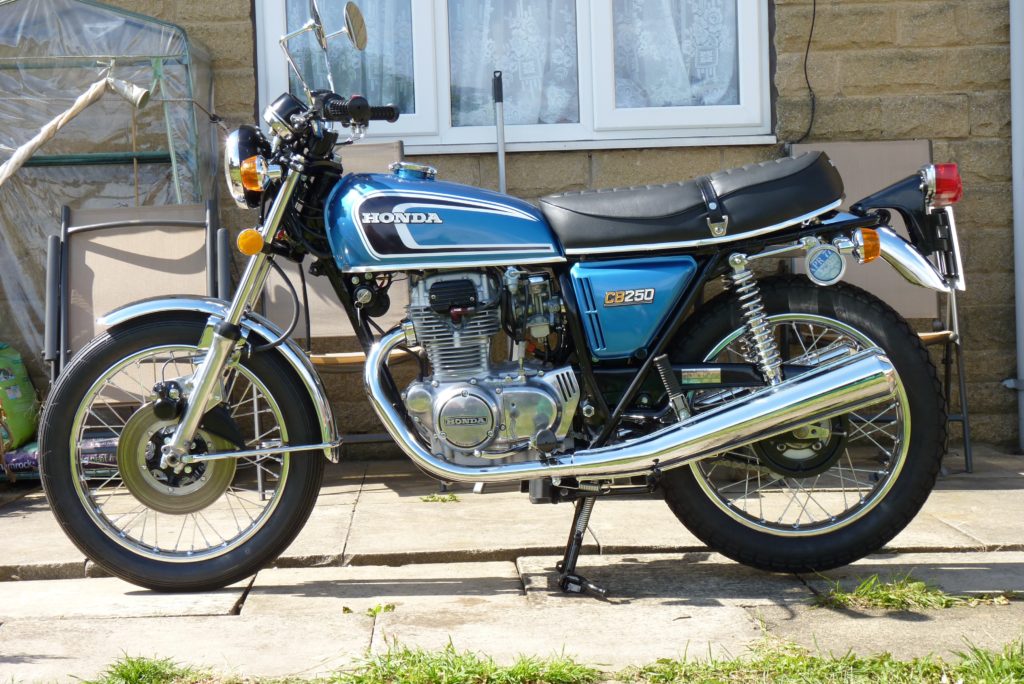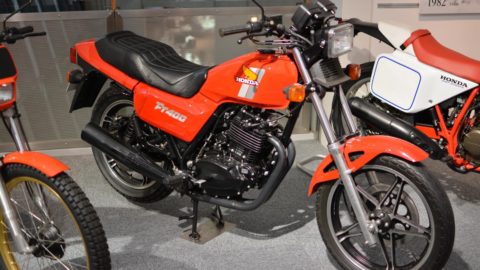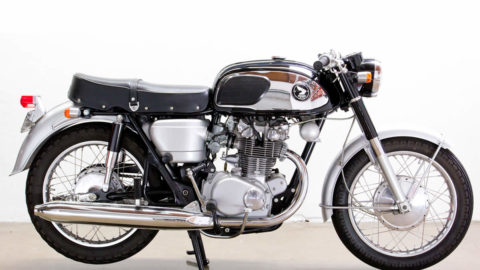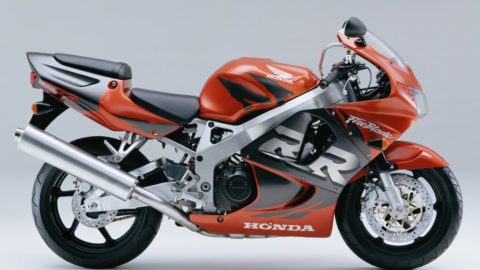The Seventies
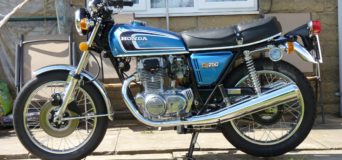
Honda CB250G5
This was a decade that began to erode Honda’s omnipresence in the manufacture of four stroke twins and fours. That they failed to really develop their sixties designs didn’t help – at least in terms of weight reduction and power output, they did at least have a more sophisticated feel. The Honda CB250G5 perfectly sums up this kind of badness. Blunted to the point of blandness, it had none of the 100mph edge of the CB250K1 with which it shared much of its design. Its touches of modernity were a six speed gearbox and a single front disc, as well as a bright paint job.
Such engineering malaise went deeper than mere blandness, the camshaft bearings (part of the cylinder head casting!) notoriously short-lived, though they could be sleeved and thus renovated. Such was the lack of power, though, that few people bothered. The CB360G5, relying somewhat less on revs for forward motion, lasted a bit longer. Come 15000 miles, more likely than not the bike had become a rolling wreck, a continuum of soggy suspension, ruined disc caliper and knocking engine bearings.
Another strange piece of engineering degeneration was the CB500T, an update on the almost legendary CB450 Black Bomber that used its stroked engine to major in a bland delivery of power and also suffered from major piston/bore problems. Handling and braking go pretty dire with age but are easily upgradeable. Replace the godawful exhaust system with something more curvaceous, a classic looking motorcycle emerges but it does haven’t the depth to pull it off.
What else did Honda do wrong at the beginning of the decade? Well, detuning the CB250K1 when they introduced the K3/4 didn’t help, though the 350 version – for all its inherent blandness – was immensely popular in the USA because there was just enough proper motorcycle in it to complement its relative ease of use and general toughness.
Don’t know if the CD175, in final iteration, was good, bad or ugly – probably all three. It almost looks like a miniature BSA, these days! Totally lacking in top end power but economical and tough. Up to a point, its brother, the CB175, was definitely good. The limit being set by how long it took for constant high rev use to burn out the valves. Where there are still CD’s tottering around there are almost no CB’s left running. The qualities of both bikes were coalesced in the CB200, which had most of the CB’s performance and most of the CD’s frugality. The mechanical front disc was good for a laugh but it was overall a very useful tool. Honda wasn’t to get close to this kind of versatility until the much later CD250.
The Benley’s that followed the demise of the earlier twins were made down to a price, though later engines held together reasonably well. Ugly as sin from new, poor build quality meant they soon became rolling wrecks. They didn’t really make it into the real world even in their final models, more a paragon of production engineering economies than anything else.
Honda’s second generation four, the CB500, was scaled down with a proper wet-sump design. Its major failing was any discernible feel of blood and guts in its 50 horses. Smooth, easy handling and generally tough it was a good motorcycle for the times, classic in style and now somewhat overpriced. The engine was scaled down and up, being incredibly bland in 350/400cc forms and somewhat vibratory and short-lived as a 650. The 550 was probably the best of the bunch but lacks the 400’s and 500’s classic status.
The CB400F was thought a gem of a motorcycle by many but its need for revs meant the piston rings could be short-lived. Its chassis was based on the CB360G5’s but redeemed itself with better suspension, weight distribution and ergonomic riding position. No surprise that prices for original, pristine CB400F’s are out of this world.
The CB750, itself, underwent no fundamental changes for almost a decade. Power was diminished, weight increased, detail work and better tolerances improving the level of engine vibration and general feel of sophistication. Even the F1 of 1975 didn’t offer a radical solution to Honda’s by then aging design though it managed to get the mass down below 500lbs and added a bit of blood and guts to the power delivery. Handling and chuckability were better than the original effort but this wasn’t much of a compliment. The whole lot should be viewed as bad in comparison to what they could have become but that many are still left on the road gives the nod to the brilliance of Honda’s production engineers.
Under heavy pressure from rivals, Honda finally went the DOHC route in 1979. Both the CB750KZ and CB900 shared a similar engine layout and chassis, defined by excessive mass, odd handling and quick rot brakes. The 900, in particular, had loads of blood and guts, could go so rapidly that the steering became plain frightening! Lacking was the total robustness of earlier fours, thrash and neglect equalled an early engine explosion. Bad bikes but in a mean and moody way that many real bikers love and appreciate.
The other much appreciated dog of the decade, the CX500. Honda’s engineers managed to produce a pushrod vee-twin that incorporated the company’s then famed camchain tensioner self-destruction routine. By the end of the decade Honda had sorted all its problems, the bike emerging as a useful workhorse until the built-in obsolescence caught up with it after 50,000 miles of abuse. But definitely a seventies dog! Woof, woof!
Yamaha were the first on the heels of Honda with a four stroke design. The XS-2 a 650cc vertical twin much in the mould of rival BSA’s and Triumph’s, save that it had an oil-tight OHC engine with a wet sump and gear primary drive. In short, the kind of motor Triumph should’ve been building in the sixties. Nothing’s that easy, the XS’s handling prone to major speed wobbles when going fast. The subsequent XS650 was less powerful, heavier, but better braked and much more stable. Have to call them good, just on the back of the immensely tough engine.
If the XS650 was as pure a piece of engineering design that ever emerged from Yippon, the XS500 messed up big time. The DOHC eight valve head was prone to overheating, the chain driven balancer awkward to adjust and therefore usually neglected. The handling was good, the mass reasonable, and the power, when the engine was running properly, better than most British 650’s. Alas, it’s one of those engines that can explode without any warning!
The XS’s were never a direct rival to Honda’s efforts but the Kawasaki Z1 definitely was! Dumping the antiquated baggage of separate oil tank and hyvoid primary chain, the 900 four added DOHC’s to the equation, emerged as the toughest and fastest piece of iron available in 1973. Kawasaki spent most of their research money on perfecting the engine, the chassis not up to the wild acceleration or speed. It was even less prone than the CB750 to an easy suspension upgrade, both steering geometry and weight distribution too far out of it for a painless redemption.
The Z1 became the better braked Z900, which in turn ended up as the Z1000, a not particularly clever transition as, like the CB750, gains in power and loss of mass weren’t in evidence, though some of the wilder handling excesses were tamed. Engine reliability and toughness remained as good as ever whilst many owners managed to get the Z1000 to trundle through the bends in a reasonable manner after doing a suspension upgrade (later front ends helping a lot).
Kawasaki’s production engineers were let loose on the Z650, not merely scaled down but using shell main bearings rather than the tougher rollers found in the Z1. The result, though, was a bike that had most of the performance of a 750 with a touch of the 500 fours easy handling. Though the bike emerged at the end of the decade it was really a seventies design, sharing much of its engine with the Z500/550, though not their camchain tensioner (which must’ve been inspired by rival Hondas).
Kawasaki lost the plot when they tried to design vertical twins. Both the Z400 and Z750 missed the whole point of the genre – light weight, simplicity – in their search for smoothness. Both sported chain driven balancer systems, which made them smooth at low revs, but absorbed power and ruined economy. Bad design but both bikes quite useful plodders if run on the back of their low rev torque.
Honda went the same route with their Dreams and Superdreams, though they didn’t over-engineer to the same extent as Kawasaki. The CB400N Suprdream the best of a bad bunch and a good bike until things began to go expensively wrong after the first 20,000 miles. Compared to the sheer purity of design of the sixties CB450, they were plain horrible, another piece of production engineering excellence that resulted in a bad end result.
Not easily forgotten, the CB400A, an automatic version of the CB400T Dream. Combine a slow reacting automatic gearbox with a detuned motor and sloppy chassis, end up with a little bit of motorcycling horror. It’s okay if you’re about 110 and like pottering around, otherwise file it as ugly and bad.
Meanwhile, in 1977, Suzuki defined how vertical twins should be built. A throwback to the CB250K series with the added benefits of a single gear driven balancer and DOHC’s. Pistons moving out of phase to give perfect primary balance, the balancer taking care of the torque reaction along the crank. This worked so well that the motor became a touch bland, the chassis was also far too remote from the road. The mill so finely thought out that the basics, albeit with watercooling and eight valves, are still there even in the latest nineties machines.
Suzuki also had a go at Kawasaki’s position as the prime producer of big fours. The GS750 soon gained a reputation for toughness that was only second to Kawasaki’s efforts. It also handled far better than rival fours. Suzuki didn’t takes any chances with the DOHC design, building in large safety factors to make sure their first fours didn’t gain a reputation for undesirable mechanical malaise. Thus it was almost as heavy as the Z1. Whilst it didn’t buckle and bump its way through the bends it needed quite a large amount of muscle to rock ‘n’ roll – but then big, heavy and wide four cylinder engines always limit the ability of the chassis. The best 750 four of the decade – as you’d expect, they had plenty of time to learn the mistakes made by earlier, rival efforts, and pick and chose the best design points.
The GS550 was more of the same, being so heavy that its 54 horses really never had a chance of producing exciting acceleration. However, the motor’s tough enough to go around the clock and the chassis so well designed that when the throttle’s slammed shut in the corners, the bike tightens up its line. Vicious use of the front discs in low speed corners will have the wheel snapping back wildly, though! Brilliant in everything except acceleration, then.
Suzuki rounded off the decade with the GS1000, more of the same but with a slightly dodgy engine and less well mannered chassis – too much mass and power to cope with, but suspension upgrades helped enormously. The GS never quite had the same cachet as the Z1000, which lived long on the mythical Z1’s prowess.
Yamaha joined in the fun at the end of the seventies with the enormous XS1100 – one bad motherf..ker if ever there was one! Excessive torque tended to tear the chassis apart but the odd maniac managed to master the beast, wheelie the thing just about everywhere and drag the undercarriage through the bends. Most riders just found them plain bad, though.
Honda manufactured the most outrageous machine of the decade, the CBX1000. All six cylinders, DOHC’s and 24 valves worth! A throwback to their sixties six cylinder racers insofar as it used the engine as a stressed member in the spine frame. Engine width was kept reasonable by placing the alternator under the carbs. Amazing engine note and smoothness, only goes bad when someone reassembles the motor wrongly – easy to do given its massive complexity! Also the great missed opportunity of the decade – why the hell didn’t they cut the motor in half, make a neat 500 triple?
Honda kept well away from the strokers, a dying breed on the back of ever stringent pollution laws. Yamaha kept the genre alive, developing their RD series into the RD400E – easily the best stroker of the decade. Not the most robust, though, that title goes to the GT500 Suzuki, a detuned version of the sublime T500 twin.
The RD benefited from Yamaha’s racing involvement, combined a slick chassis with an eager motor, yet one that would also plod along without throwing a fit, thanks to the reed valves between carbs and induction ports, and electronic ignition. All the RD’s, from 125 to 350cc, were also good stuff but Yamaha managed to turn stroker orthodoxy on its head – it was usually the smaller strokers that ran best!
The GT500, despite its larger engine, lacked the edge of the smaller stroker but was still a useful alternative to the four stroke twins and fours, whose power output it tried hard to emulate. If not the snappiest device on the road, the GT was at least easy to ride and long lasting.
Suzuki’s obsession with matching the bland running of Honda’s middleweights went deeper with their stroker triples, the GT380 and 550. The advantages of strokers – low mass, high power and relative simplicity – completely missing. Throw in far from robust natures, the centre cylinder in particular subject to all kinds of mechanical infidelity, to define these bikes as pretty pointless. Both bad and ugly.
Suzuki had more luck with their smaller strokers, everything that was good in the breed culminating in the final rendition – the GT250X7. The earlier Ram-Air GT250 was a bit too muted and the GT185 twin prone to expensive self-destructive habits. No, the X7 managed to blend minimal mass, 100mph performance, adequate handling and marginal toughness – not as robust as the rival RD250 but on the pace with that bike. The old GT125 twin was usually thrashed into the ground by learners, so they are all bad by now if not in their day.
If Suzuki messed up their stroker triple designs, Kawasaki at least got the basics right with the infamous H1 – a huge, direct, surge of power; only 60 horses, but it all seemed to switch on at once, with a delightful stroker triple howl – not to mention cloud of pollutants. This power did nasty things to the primitive chassis that didn’t really have a clue about steering geometry, weight distribution or the integrity of the chassis bearings. Thus barrelling out of bends with the power coming in would cross up the chassis something rotten whilst hastily backing off turned the back end totally plastic. And the rider spastic if he wasn’t lucky!
Later, the triple was developed into 250, 400 and 750cc versions, the 500 becoming both milder and more controllable, but it’s the H1 that really stands out as the maddest bike of the decade. The 750 actually had quite a lot of low rev torque but its power was too much for the chassis, and its engine was never particularly reliable. Later 400 triples muted the breed into a semblance of civility whilst still being able to blow off midrange Honda fours, and the like.
The 250 triple, in early versions, wasn’t the ideal tool to learn on but had the status of being able to do the ton on a good day. On a bad day, it’d oil all its plugs or throw the rider off the road, though the chassis, due to the relative lack of power and mass, had the easiest time of all the triples. Argue about any Kawasaki triple as to whether it was good or bad but none of them could ever be called ugly.


